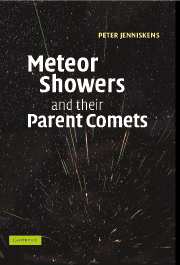Book contents
- Frontmatter
- Dedication
- Contents
- Preface
- Acknowledgements
- Part I Introduction
- Part II Parent bodies
- Part III Young streams from water vapor drag
- Part IV Young streams from comet fragmentation
- Part V Old streams and sporadic meteoroids
- Part VI Impact and relevance of meteor showers
- 32 Impact!
- 33 Meteor showers on other planets
- 34 Meteors and the origin of life
- Appendix
- Tables
- Index
- Units and constants
32 - Impact!
from Part VI - Impact and relevance of meteor showers
Published online by Cambridge University Press: 05 July 2015
- Frontmatter
- Dedication
- Contents
- Preface
- Acknowledgements
- Part I Introduction
- Part II Parent bodies
- Part III Young streams from water vapor drag
- Part IV Young streams from comet fragmentation
- Part V Old streams and sporadic meteoroids
- Part VI Impact and relevance of meteor showers
- 32 Impact!
- 33 Meteor showers on other planets
- 34 Meteors and the origin of life
- Appendix
- Tables
- Index
- Units and constants
Summary
Meteor showers are a threat to satellites in orbit and an early warning of comet impacts that could one day threaten our very existence. Each year, Earth is hit by 20 000 tons of meteoroids, <1 kg in mass, 10 million meteors brighter than +6.5m, at a rate of ∼1000 visible meteors per second, but by only one superbolide. And only once every 100 million years does a 10 km sized minor planet hit. Despite these disparate frequencies, each group brings in about the same amount of mass (Fig. 32.1).
32.1 Giant impacts
A 10 km sized minor planet would instantly blind any casual observer by its blazing −45m fireball and create a 100 km sized crater from the explosion on impact, if not all of the cosmic speed is dissipated in the atmosphere. The last eye witness of such a giant impact was likely to have been a dinosaur 65 million years ago, when all its relatives but the birds died after a 10 km minor body hit the Yucatan Peninsula of Mexico in what was then a shallow sea. The 180–300 km diameter crater is now buried by 300–1000 m of limestone. At that time, much of the asteroid or comet survived the atmosphere and when it hit the ground, so much energy was released that the rock (a limestone ocean bed rich in carbonates and sulfates) was vaporized out to a distance of 6–12 km from the impact point. The vapor was super hot at thousands of degrees Celsius, expanding rapidly into a plume rising from the ground into space along the fireball track and ultimately encircling the whole Earth. For thousands of miles around the crater there was a rain of molten droplets (tektites) and debris. Low-lying areas near the coast of the shallow sea were inundated by a tsunami. For weeks, the impact heat of the explosion and the heated atmosphere would have caused fires that would have released soot and carbon dioxide into the atmosphere.
- Type
- Chapter
- Information
- Meteor Showers and their Parent Comets , pp. 547 - 560Publisher: Cambridge University PressPrint publication year: 2006



